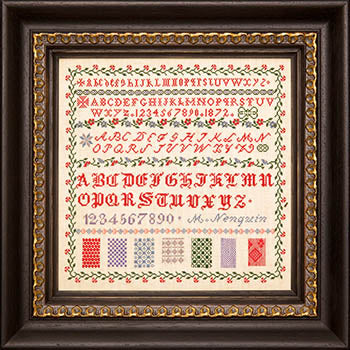Bee Youtiful Sip and Stitchery
M Nenquin - Hands Across the Sea Samplers
M Nenquin - Hands Across the Sea Samplers
Couldn't load pickup availability
Whilst samplers were stitched by girls to demonstrate their stitching skills (cross stitch), they could include sewing skills such as structural sewing, mending, and patchwork. In centuries past, clothing and household linen were not thrown away if damaged, as they were valued possessions. Women spent many hours mending, darning, and patching. Extending the life of garments and linens was not only a necessity but a valuable skill. Young girls learned to darn, patch, and mend either from their mothers or as a part of their education.
Mending is when a tear is repaired using a line of stitching. Patching is when a piece of cloth is used to repair a hole in the ground material by covering it. Darning is characterised by the use of thread to replicate the structure of the fabric, and although it was meant to be invisible, sometimes different coloured threads were used to embellish the fabric. The darning blocks found in samplers with weave structures were designed to show that the girl could repair a variety of different weaves.
We believe that this eye-catching sampler is Belgian. Although the needleworker only stitched the name “M Nenquin” on her sampler, it is possible that she was Marie Philomène Nenquin who was born on December 26, in the year 1853 at Gimnée, Namur, Belgium. Marie’s parents were Désiré Nenquin and Anne Joseph Landry. Marie married Léon Poucet on December 3, 1875 and sadly died six years later on May 23, 1881 at only 28 years of age. Less than two years later, Léon remarried.
Marie executed her sampler predominantly with cross stitches laid over two threads of linen; the darning panels are worked with running stitches of varying lengths. The sampler is suitable for needleworkers of all levels of ability; however, please note that the darning panels cannot be worked on Aida.
The design area is 209 stitches (w) x 201 stitches (h). These calculations have included a 3" margin for finishing and framing. The model was stitched on 56ct linen, and we recommend that you use linen dyed to a rich cream colour to showcase your needlework.
28ct linen: Design: 14.93" x 14.36" Fabric: 20.93" x 20.36"
32ct linen: Design: 13.06" x 12.56" Fabric: 19.06" x 18.56"
36ct linen: Design: 11.61" x 11.17" Fabric: 17.61" x 17.17"
40ct linen: Design: 10.45" x 10.05" Fabric: 16.45" x 16.05"
46ct linen: Design: 9.09" x 8.74" Fabric: 15.09" x 14.74"
56ct linen: Design: 7.46" x 7.18" Fabric: 13.46" x 13.18"
Share


